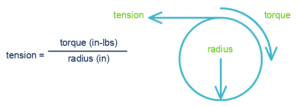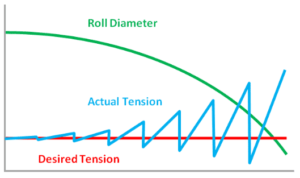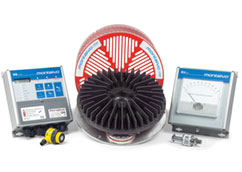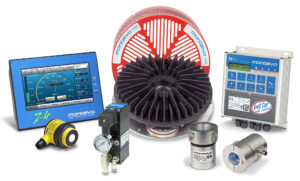Look around you, many of the products you see and use, are manufactured using some sort of tension control system. From your morning cereal packaging to the label on your water bottle, everywhere you look there are materials that depend on accurate tension control during the manufacturing process. Companies around the world know that correct tension control is the “make it or break it” feature in these manufacturing processes. But why? What is tension control, and why is it so vital in the manufacturing industry?
Before we dive into tension control, we should start by understanding what tension is. Tension is the pull or strain put on material that tends to stretch it in the direction of the force applied. In the manufacturing process, this usually begins when a material is pulled into the process by the downstream process point. We define tension as the torque applied at the center of the roll, divided by the roll radius. Tension = Torque / Radius (T=TQ/R). The wrong amount of Tension can cause the material to elongate and damage the shape of the roll when too much tension is applied, and if the tension exceeds the shear strength of the material it can even break the web. On the other hand, too little tension could also damage your end product. Insufficient tension could lead to telescoping or sagging rewind roll, ultimately causing low-quality end product.

And to understand tension control, we need to understand what is referred to as a “web“. This term refers to any material that is continuously fed from and/or a roll, such as paper, plastic, film, filament, textile, cable, or metal, and more. Tension control is the act of maintaining the desired amount of tension on the web, based on the needs of the material. Meaning the tension is measured and maintained at the desired setpoint, thus allowing the web to run smoothly throughout the entire production process. Tension is generally measured in either the imperial system of measurement, in terms of pounds per linear inch (PLI), or metric, in Newtons per centimeter (N/cm).
Proper tension control aims to have the precise amount of tension on the web, so the stretch is carefully controlled and kept to a minimum while keeping the tension at desired levels throughout the entire process. The rule of thumb is to run the least amount of tension you can get away with to produce the quality end product you desire. If tension is not accurately applied throughout the process it could lead to wrinkles, web breaks, and poor process results such as interweaving (slitting), out of registration (printing), inconsistent coating thickness (coating), length variations (sheeting), material curl during lamination processes, and roll defects (telescoping, starring, etc.) just to name a few.
Manufacturers are under pressure to keep up with the growing demand of producing quality products as efficiently and effectively as possible. This results in the demand for better, higher-performing, and higher quality, production lines. Whether it’s converting, slitting, printing, laminating, or other processes, each of these shares a common trait – proper tension control is the difference between high quality, cost-efficient production, and lower quality, expensive production with excess scrap and frustration over broken webs.
As a worldwide leader in manufacturing high-quality Web Tension Control equipment, and with over 75 years of industry-specific knowledge, experience, and expertise, Montalvo knows that each customer and each process needs to be evaluated on its own merit and the appropriate solution is supplied. For maximum production efficiency, and minimum downtime and waste, tension control cannot and should not be left to chance. Montalvo knows Tension Control and Material Handling.

There are two primary methods for controlling tension, manually or automated. With manual control, the operator’s attention and presence are continually required in order to manage and adjust the speed and torque throughout the process. With automated control, operator input is only needed for initial setup as the controllers are responsible for maintaining the desired tension throughout the entire process. Thus, reducing operator interaction and dependency. Montalvo refers to this superior solution as “Set It and Forget It.” And within the automated control offerings, there are typically two types of systems offered, Open Loop and Closed Loop Control.
Open- Loop Systems

In an open-loop system, there are three primary elements: the controller, the torque device (brake, clutch, or drive), and the feedback sensor. The feedback sensor commonly focuses on providing diameter reference feedback and the process is controlled proportionally to the diameter signal. As the sensor measures the changes in diameter and relays this signal to the controller, the controller proportionally regulates the torque of the brake, clutch, or drive to maintain tension. While this system is not continually adjusting based on an actual measurement of tension, Montalvo has developed open-loop tension control systems providing automated tension control that can be accurate within approximately 8 – 10% of the desired tension level throughout the process.
Closed- Loop Systems

The advantage of a closed-loop system is that it continually monitors and adjusts the web tension to keep it at the desired setpoint resulting in 96-100% accuracy. With a closed-loop system, there are four primary elements: the controller, the torque device (brake, clutch, or drive), the tension measurement device (Load Cell or Dancer Arm), and the measurement signal. The controller receives direct material measurement feedback from the Load Cell or Dancer Arm. As tension changes, it produces an electrical signal that the controller interprets in relation to set tension. The controller then regulates the torque of the torque output device to maintain the desired setpoint. Just as cruise control keeps your automobile at a preset speed, a closed-loop tension control system keeps your web tension at a preset amount of tension.
So, you can see that “Good Enough” is typically no longer good enough in the world of tension control. Tension control is a significant and vital component of any high-quality manufacturing process, often what separates a “good enough” process from one that is a productivity powerhouse of higher quality materials and end products. Adding an automated tension control system expands both the existing and future capabilities of your process while delivering critical benefits for you, your customers, their customers, and beyond. Montalvo’s tension controls systems are designed to be drop-in solutions for your existing machine delivering a quick return on investment. Whether you need an open-loop or closed-loop system, Montalvo will help you determine that and provide you the productivity and profitability increase you desire.


